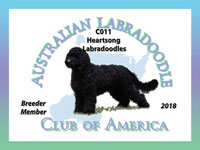Breed Standard of the Australian Labradoodle
Citation
Derived from "Breed Standard of the Australian Labradoodle", 1997, Angela Cunningham and Beverley Manners, revised 2000, 2003 by Angela Cunningham, revised 2005 by Angela Cunningham and Beverley Manners. Adopted by the Australian Labradoodle Club of America, October 2005.
All photos contained in the standard provided courtesy of Tegan Park.
Standard
Temperament and soundness are the two key elements in a good family companion; they must not be sacrificed for any reason.
General Appearance
The Australian Labradoodle should be athletic and graceful, yet compact with substance and medium boning. They are joyful and energetic when free yet soft and quiet when handled. They should approach people in a happy friendly manner with eye to eye contact and are keen to learn, and easy to train. They have a free flowing wavy or curly coat that does not shed and is possibly non-allergenic.
Size
Sizes are still somewhat inconsistent with no definition between male and female at this time. Accurate prediction of size even by an experienced breeder is not expected at this time. Size is measured from the top of the shoulder blades (wither) standing squarely on a level surface.
Much care is needed when breeding both the large and small dogs. Large dogs can suffer from rapid growth that can lead to structural problems. Soundness is of utmost importance. Over size is a major fault. Great care must be taken to keep the miniature Australian labradoodle a solid athletic robust dog. The Dwarfing of dogs can lead to many genetic and temperament disorders. Minimum size attention is of the utmost importance to maintain a healthy little dog. Most Australian Labradoodles will weigh more than their height reflects.
Standard
Standards range between 21 and 24 inches. The ideal size for a standard female is 21 to 23 inches and for a male the ideal size is 22 to 24 inches. Weight range tends to be 50 to 65 pounds.
Medium
Mediums range between 17 and 20 inches. The ideal size for a medium female is 17 to19 inches and for a Male the ideal size is 19 to 20 inches. Weight range tends to be 30 to 40 pounds.
Miniature
Miniatures range between 14 and 16 inches. The ideal size for a miniature is 14 to 16 inches. Weight range tends to be 16 to 25 pounds. There should be no correlation between height and sex of the miniature Australian Labradoodle.
Most Australian Labradoodles will weigh more than their height reflects
Body
The height to length ratio should be 10 to 12, being slightly longer in leg, than body, but still appearing square and compact. Shoulders should have good angulation with firm elbows held close to the rib cage. Hindquarters should be of medium angulation with short strong hocks. Top line should remain level with strong loin and level croup. They are also a galloping dog, therefore, the flanks should rise up from a brisket set just below the elbows but should not be excessively deep. Ribs should be well sprung but not barreled. Overall the dog should appear square, balanced, athletic, and with good muscling.
Movement
Trotting should be purposeful, strong and elastic, with good reach and drive, and giving the appearance of "going somewhere" When happy, relaxed, or at play they will prance and skim the ground lightly. Excessive tightness in the hips will produce a stilted action and is considered a fault. The top line should remain level with a strong loin and level croup. They are also a galloping dog, therefore, the flanks should rise up from a brisket set just below the elbows but should not be excessively deep. Ribs should be well sprung but not barreled. Overall the dog should appear square, balanced, athletic, and with good muscling.
Tail
The tail is set relatively high and is preferred to be carried in a saber. It may be carried below the topline or gaily above. Curled possum type tails are undesirable.
Head
The head is sculptured, broad, with well-defined eyebrows, a medium stop, eyes set well apart, and nose to eye slightly longer than eye to occiput. The head should be clean and chiseled and fully coated as on the body legs and tail.
Ears
The ears are moderately flat against the head and the base should be level with the eye. Leather should be of medium thickness and when gently drawn forward should reach the top canine tooth. Ear leather reaching beyond the tip of nose is considered a servere fault. Ear canals should be free of excessive hair and not thick and bulbous, When inquisitive and alert the ear set should rise to the top of the head. Thick, heavy ear leather is a fault.
Eyes
The eyes are slightly round, large, expressive, and always offering eye to eye contact when engaged in activity with a human. Protruding or sunken eyes are a fault. Watery or tearful eyes are a fault. Wide round or narrow almond shape eyes are considered faults.
Eye Colour
Eye colour should complement and blend with the face colour, Black, Blue, Red, Dark Chocolate and silver dogs must have dark brown eyes. All shades of Cafe`, Milk Chocolate, Apricot/Gold, Creams, and Chalk should have dark hazel to brown eyes if they have black pigment. Caramel and dogs with rose pigment can have either dark eyes or "ghost" eyes. Ghost is a hazel colour range much the same as it is in humans. Flecking with different shades of hazel with green and a blue/green make this eye colour quite unique. Ghost eyes must always remain soft in appearance. Cold staring or expressionless appearance in all eye colours, is a severe fault.
Teeth
Only a scissor bite is acceptable and must not be undershot nor overshot. Miniatures must never have crowding teeth.
Nose
The nose is large, square, fleshy and pigmented black or rose. Pigment should be strong. A dogo with black pigment must have dark brown eyes. Pink spots or patches on the nose, lips, eye rims, or pads are a fault. Dogs with rose pigment can have dark hazel, brown or ghost eyes. Eye rims, nose, lips, and pads should be rose. Pink spots or patches are a severe fault. Rose should be a rich, liver colour.
Neck
The neck is firm and well muscled. It should be moderately long, slightly arched, and flow into well angled shoulders with no appearance of abruptness. The neck should not be coarse or stumpy and should lend an air of elegance to the dog. A short thick neck is a fault.
Colour
Any solid colour including Café and Silver is preferred. Minimal white on the chest and toes is acceptable , Light chalky course hairs, or kemp, sprinkled through a dark coat is permissible but very undesirable.
Parti and Phantoms, though undesirable, are considered an acceptable colour. Parti can be any colour except Phantom with white on the face, head, and body. Phantoms are any shading or two tone coloration such as black with lower legs showing a soft toning of silver or gold, or a dog born dark with a golden shading at the roots or a slight brindling effect. True, pure solid colours, with the exception of Silver and Café are highly prized and are the ideal for the Australian Labradoodle.
It is normal that all colours may show bleaching and discoloration over the top coat. This is called sunning and is quite expected and acceptable as the Australian Labradoodle is an active dog and often a service dog that enjoys the outdoors. Weather bleaching, or sunning, must not be penalized.
Pigmentation
- Gold/Apricot: Must have black pigment.
- Red, Black, Silver and Blue: Must have black pigment.
- Caramel, Chocolate, Café, Parchment and Lavender: Must have Rose pigment.
- Chalk: Appears white but when compared to a true white is seen as chalky white. Chalk may have rose or black pigment.
- Cream and Apricot Cream: All shades and combinations of cream are acceptable may have rose or black pigment.
- Caramel: Should be a rich Apricot/Gold, very much the same colour as its namesake - caramel, through to a deep red and must have rose pigment.
Colour Standards
- Red is a solid, even, rich red colour which should have no sprinkling of other colours throughout the coat. A true Red must not be lighter at the roots than at the tips of the coat. Red can fade somewhat with age and senior dogs showing paling of coat should not be penalized.
- Gold, also called Apricot, is the colour of a ripe apricot on the inside. A true Apricot must not be lighter at the roots than at the tips of the coat. It can come in varying shades and may fade as the dog grows older. Senior dogs should not be penalized for paling of coat colour.
- Blue should be a dark to medium smokey blue. Blue dogs are born black but will have blue skin and undertones at a young age. Any other colour throughout the Blue is undesirable. Blue belongs to the Rare colour group.
- Silver dogs are born black, will have more of a grey skin, and will develop individual silver fibers at a young age. Silver dogs can take up to 3 years to colour out and become a beautiful smoky grey through to a light iridescent platinum and varying shades in-between at adulthood. Uneven layering of colour in the silver is normal.
- Chocolate is dark and rich and are born almost black. They maintain a dark chocolate throughout their lifetime. Colour should be even and any other colour throughout the chocolate is highly undesirable. Chocolate belongs to the Rare colour group.
- Café dogs are born milk chocolate of varying shades and have the same gene as silver. They often take up to 3 years to fully colour out to multi shades of chocolate, silvery chocolate, and silver throughout. When given plenty of sunshine, in time they develop stunning highlights.
- Lavender should be a definite, even smokey lavender chocolate, giving an almost pink or lilac appearance. Lavender dogs are born Chocolate and can be difficult to distinguish at a young age. Any other colour throughout the Lavender is highly undesirable. True Lavender belongs to the Rare colour group.
- Parchment dogs are born milk chocolate which will pale to a smokey creamy beige. Paling usually starts from an early age, often as early as 6 weeks. Adults they can be mistaken for dark smokey cream from a distance. Parchment belongs to the Rare colour group.
Coat
Coat types are still very sporadic with many dogs showing a combination of multiple types. As the genetic values stabilize we hope the ideal coats are as follows.
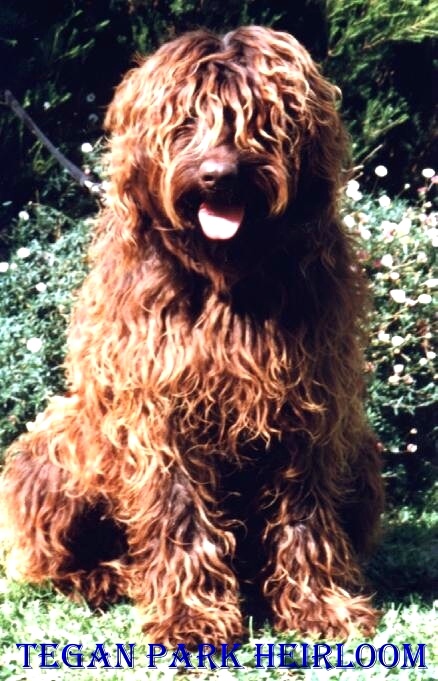 Fleece |
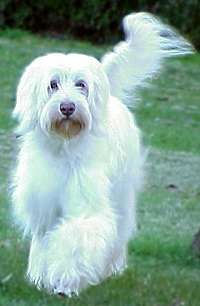 Wavey Fleece |
 Wool |
|---|
Fleece length is usually around 5 inches long. The Fleece coat texture should be light and silky quite similar to that of an Angora goat. Appearing to contain a silky lanolin. The fleece coat can be from loosely waved, giving an almost straight appearance, to deeply waved. Kemp is often found around the eyes and topline. The absence of kemp is highly prized.
Wool coats are more dense to the feel, like a sheep's wool. The ideal wool coat should hang in loose hollow spirals. Most wool coats are still exhibiting a good texture but take the appearance of a spring rather than a spiral. The sprung wool coat is not desirable. A thick, dense coat is also not desirable. The Australian labradoodle has a single coat. Both the fleece and the wool coat should naturally grow in staples and be of a soft texture. Both the ideal fleece and wool coats spin successfully.
A hair coat, a hair like texture that sheds, is a fault and is undesirable.
With the exception of the hair coat, which is usually seen in early generation dogs, there should be no body odor or shedding. It is acceptable to change coats from puppy to adult and also during hormonal changes in fertile bitches. This coat must not shed, but should be groomed out. It is important that the coat gives the impression of being a fleece rather than dog hair.
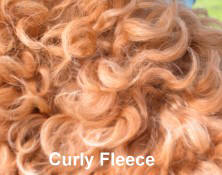
|
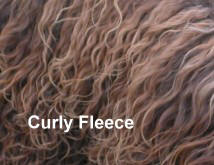
|
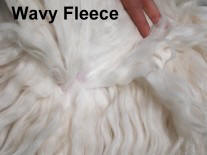
|
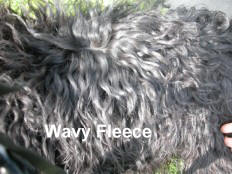
|
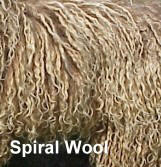
|
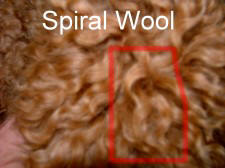
|
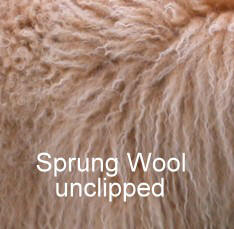
|
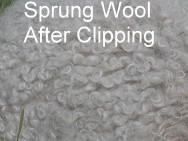
|
The ideal coat presentation should give the viewer the impression of a casual natural appearance. Scissoring along the topline , neckline, under the ears, and around toes should be done without giving a manicured look. The trimmed coat should maintain a flowing, natural wash and wear look and at all times highlighting the staples and ringlets. An excessive groomed presentation is a fault.
There is no scientific proof that the Australian Labradoodle is hypoallergenic. Practical research has given the impression that it is highly possible that the fleece and wool textures of the Australian Labradoodle are very successful with asthma and allergy sufferers.
Temperament
The Australian Labradoodle is extremely clever, sociable, and joyful. They are easily trained and quick to learn unusual or special tasks. Active and a little comical at times, they may attempt to out smart their owners if undisciplined. They are friendly, though obviously loyal to their own family, and non-aggressive.
Breeding Considerations
In these infant years of breeding the Australian Labradoodle, some throw backs with wiry, sparse, or multiple type coats are not to be discarded but assessed on their soundness of body and temperament. Many of these individuals offer valuable hybrid genetics and will breed on to produce excellent offspring. The same applies for dogs displaying undesirable colour or size traits. In order to produce a breed of quality, progress must be made slowly. Genetic resources must be kept broad to protect the Australian Labradoodle breed from the disasters that many other breeds are suffering, the "genetic dead end".
Special attention must be directed to soundness. It is the responsibility of conscientious breeders to test their dogs and protect the Australian Labradoodle from developing genetic disorders. It is good to keep in mind that the Australian Labradoodle is a family companion. We do not want the heartache of illness and the expense of less than sound dogs.
